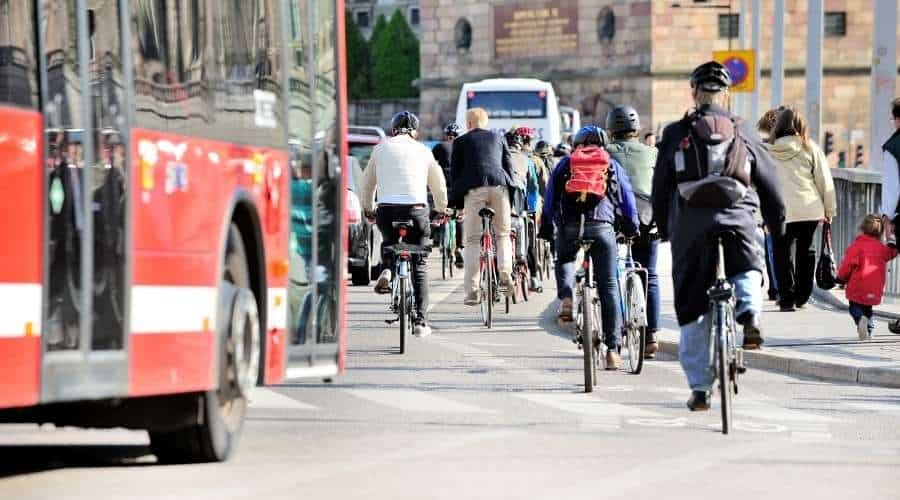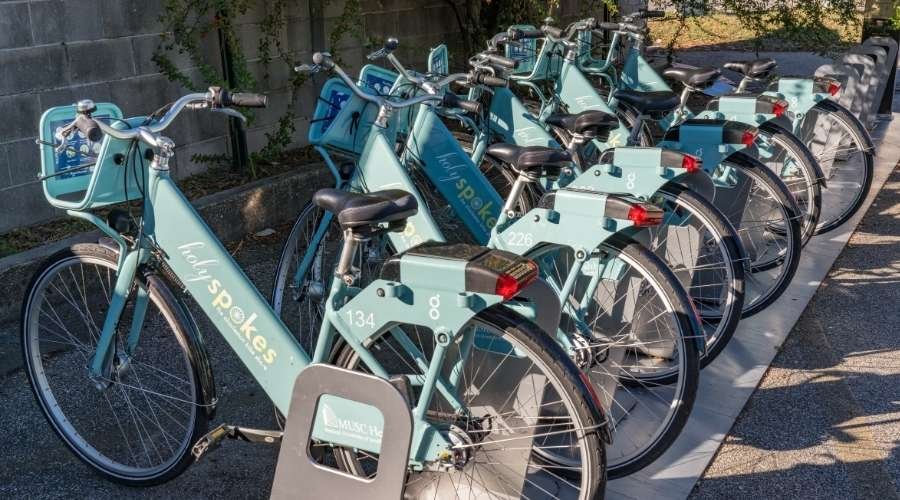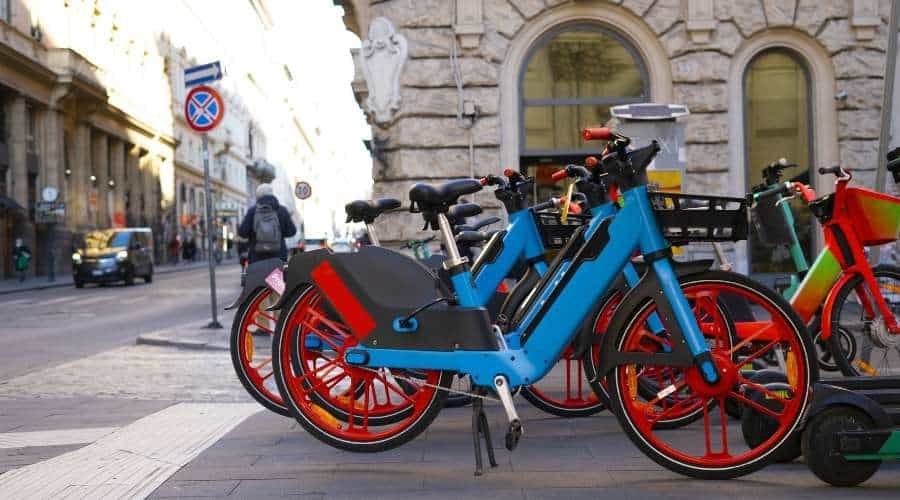If you live in a city, you’re probably familiar with the common challenges of urban mobility: traffic congestion, long commutes, and limited parking, to name a few. As cities continue to grow, the need for efficient and sustainable transportation options becomes more pressing. One solution that has gained popularity in recent years is the integration of e-bikes with public transportation.
The integration of e-bikes with public transportation offers several potential benefits, including reduced traffic congestion, improved air quality, and increased accessibility to public transportation for people who live farther away from transit stations. However, there are also concerns about the safety of e-bikes on roads and bike lanes, as well as the potential for theft and maintenance issues with shared e-bike systems.
In this article, we’ll navigate the electrifying world of e-bikes integrated into public transportation. We’ll delve into the advantages, scrutinize the challenges, and, by the article’s end, have a clearer picture of whether this fusion is the urban mobility revolution we’ve been waiting for.
E-Bike and Public Transportation: A New Mode of Transportation

If you live in a city, you know that getting around can be a hassle. Public transportation can be slow and crowded, and driving a car can be expensive and stressful. But what if there was a new mode of transportation that combined the best of both worlds? Enter the e-bike.
E-bikes are bicycles that are equipped with an electric motor that assists with pedaling. They can be ridden like a regular bike, but the electric motor makes it easier to climb hills and travel longer distances. E-bikes are becoming more popular as a mode of transportation, especially in urban areas.
E-bikes are emission-free and take up less space on the road than cars, making them a more sustainable option for urban transportation.
One of the biggest advantages of e-bikes is that they can be integrated with public transportation. Many cities are now offering bike-sharing programs that allow riders to rent e-bikes from docking stations located near public transportation stops. This makes it easy to use the e-bike for the first or last mile of your journey, and then switch to public transportation for the rest of the trip.
Using e-bikes in conjunction with public transportation can have several benefits. For one, it can reduce traffic congestion and air pollution. E-bikes are emission-free and take up less space on the road than cars, making them a more sustainable option for urban transportation.
Additionally, e-bikes can be a more affordable option than driving a car or taking a taxi. They require no fuel and have lower maintenance costs than cars. Plus, bike-sharing programs are often more affordable than traditional public transportation options.
However, there are also some challenges to integrating e-bikes with public transportation. For one, there may not be enough docking stations or e-bikes available to meet demand. Additionally, riders may be hesitant to use e-bikes if they are unfamiliar with them or if they are concerned about safety.
Despite these challenges, the integration of e-bikes with public transportation is an exciting development for urban mobility. It has the potential to create a more sustainable and affordable transportation system while also improving the quality of life for city dwellers.
The Rise of E-Bikes

You’ve probably seen them zipping around town, the battery-powered bicycles that are becoming increasingly popular. These electric bikes, or e-bikes for short, have been around for a while, but in recent years they’ve really taken off.
Sales of e-bikes have been steadily increasing, with some estimates suggesting that they could account for up to 50% of all bicycle sales in the near future. One reason for this surge in popularity is the fact that e-bikes are much easier to ride than traditional bicycles. The battery-powered motor provides assistance to the rider, making it easier to pedal up hills or cover long distances without breaking a sweat.
But e-bikes aren’t just popular with commuters and casual cyclists. They’re also being used by delivery companies, couriers, and other businesses that need to transport goods quickly and efficiently. In fact, some cities are even experimenting with e-bike sharing programs, which allow residents to rent e-bikes for short periods of time.
One of the main advantages of e-bikes is that they’re environmentally friendly. Unlike cars and other vehicles that run on fossil fuels, e-bikes are powered by batteries, which can be recharged using renewable energy sources like solar or wind power. This makes them an attractive option for cities that are looking to reduce their carbon footprint and improve air quality.
So, are e-bikes a blessing or a curse for cities? It’s hard to say for sure, but one thing is certain: they’re here to stay. As the technology continues to improve and more people adopt e-bikes as their primary mode of transportation, we’re likely to see even more changes in the way we get around our cities.
E-Bikes and Cycling Infrastructure

If you’re an avid cyclist, you probably know how important cycling infrastructure is. Bike lanes and bike-sharing programs have made cycling in cities much more accessible and safe. E-bikes, with their ability to go farther and faster than traditional bikes, have added a new dimension to cycling infrastructure.
E-bikes can be used on regular bike lanes, but they can also be used on roads with higher speed limits. This means that cities need to consider the impact of e-bikes on their cycling infrastructure. For example, bike lanes may need to be widened to accommodate the faster-moving e-bikes. Additionally, e-bike riders may need more protection from traffic, which could mean adding more physical barriers between bike lanes and car lanes.
E-bikes can be used on regular bike lanes, but they can also be used on roads with higher speed limits.
Bike-sharing programs have also embraced e-bikes. Many cities have added e-bikes to their bike-sharing fleets, which has made them more accessible to people who might not have considered cycling before. In some cases, e-bikes have even replaced cars for short trips.
One potential downside to e-bikes is that they may discourage people from using traditional bikes. However, studies have shown that e-bikes actually encourage people to cycle more often and for longer distances. This is because e-bikes make cycling less intimidating and more accessible to people who might not be able to handle a traditional bike.
Overall, e-bikes have the potential to revolutionize cycling infrastructure. They make cycling more accessible and can help reduce car traffic in cities. However, cities need to carefully consider the impact of e-bikes on their cycling infrastructure and make sure that bike lanes and other cycling infrastructure can accommodate the faster-moving e-bikes.
E-Bikes vs Traditional Cars and Buses

Are you tired of sitting in traffic during your daily commute? Do you want to reduce your carbon footprint while still getting around efficiently? E-bikes may be the solution for you.
Compared to traditional cars and buses, e-bikes have several advantages:
- Cost-effective: E-bikes are much cheaper to purchase and maintain than cars or buses. They also require less fuel and have a longer lifespan.
- Eco-friendly: E-bikes produce zero emissions and have a much smaller carbon footprint than traditional cars and buses.
- Convenient: E-bikes are smaller and more maneuverable than cars and buses, making them easier to park and navigate through traffic.
- Healthy: Riding an e-bike provides exercise and fresh air, which can improve your physical and mental health.
While traditional buses and public transportation may seem like the more practical option, they also have several drawbacks:
- Limited routes: Bus lines and bus services may not cover all areas of a city, making it difficult for commuters to reach their desired destinations.
- Crowded: Buses can become overcrowded during peak hours, making for an uncomfortable and stressful commute.
- Unreliable: Buses are subject to traffic and other delays, making it difficult to plan your day around them.
In contrast, e-bikes are a flexible mode of transportation that can be used for both short and long distances, and can be taken on any route or path. They also offer a more personalized and enjoyable commuting experience.
In conclusion, while traditional cars and buses may seem like the more practical option for commuting, e-bikes offer several advantages that make them a viable alternative. They are cost-effective, eco-friendly, convenient, and healthy, and provide a more personalized and enjoyable commuting experience.
Impact of Pandemic on E-Bike Usage

The COVID-19 pandemic has had a significant impact on the way people travel and use public transportation. With the fear of contracting the virus, many people have been hesitant to use public transportation, leading to a surge in the popularity of e-bikes. According to the Precedence Research, e-bike sales increased by 145% from 2019 to 2020.
As public transportation ridership declined during the pandemic, cities began rolling out fleets of electric motor bikes, or e-bikes, to provide a safer and more convenient mode of transportation. This has led to a boom in e-bike usage in cities across the United States. In fact, some cities have seen a significant increase in e-bike usage during the pandemic.
For example, according to NBC News, the cities seeing the biggest increase in e-bike usage include Portland, Oregon; New York City; San Francisco, California; and Washington, D.C. These cities have all seen a surge in e-bike usage as people look for alternative modes of transportation during the pandemic.
The rise in e-bike usage during the pandemic has also highlighted the need for public policy to keep pace with this trend. As e-bikes become more popular, it is important for cities to invest in infrastructure that supports and encourages e-bike usage. This includes the development of bike lanes and other infrastructure that makes it easier and safer for people to use e-bikes as a mode of transportation.
In conclusion, the COVID-19 pandemic has had a significant impact on e-bike usage, with many people turning to e-bikes as a safer and more convenient mode of transportation. As e-bikes become more popular, it is important for cities to invest in infrastructure that supports and encourages e-bike usage.
E-Bike Sharing Systems

If you live in a city, chances are you’ve seen people zipping around on electric bikes, or e-bikes, as part of a bike-sharing program. E-bike sharing systems are becoming increasingly popular around the world as a way to reduce traffic congestion, air and noise pollution, and energy consumption.
E-bike sharing systems are similar to traditional bike-sharing programs, but with the added benefit of electric assistance. This means that riders can travel farther and faster with less effort, making e-bikes a great option for commuting or running errands.
One example of a successful e-bike sharing system is Chicago’s Divvy program, which plans to have 10,000 e-bikes in its system by 2022. Lyft also offers e-bikes for rent in select cities, including New York and San Francisco.
E-bike sharing systems can also be a great way to complement or compete with existing public transportation options. For example, e-bikes can be used as a last/first mile of transport, allowing riders to easily get to and from public transit stations.
Overall, e-bike sharing systems have the potential to be a blessing for cities, providing a convenient, eco-friendly transportation option for residents and visitors alike. However, it’s important to ensure that these systems are implemented in a safe and responsible manner, with proper infrastructure and regulations in place to protect riders and pedestrians.
Maintenance and Theft Concerns

When it comes to E-bikes and public transportation integration, maintenance and theft concerns are two of the most significant issues that cities face. While E-bikes are generally low maintenance, they still require regular upkeep to keep them running smoothly. This can be a challenge for cities that are already struggling to keep up with the maintenance of their public transportation systems.
One way to address this issue is to partner with E-bike sharing companies that provide maintenance services. These companies can take care of the maintenance of the E-bikes, ensuring that they are always in good working condition. This can save cities a lot of time and money, as they do not have to worry about maintaining the E-bikes themselves.
Another concern is theft. E-bikes are more expensive than traditional bicycles, which makes them a more attractive target for thieves. Cities need to take steps to prevent E-bike theft, such as providing secure bike parking facilities and encouraging riders to use sturdy locks.
In addition, cities can also use technology to prevent E-bike theft. For example, some E-bikes are equipped with GPS tracking devices that can help locate stolen bikes. Cities can also use surveillance cameras to deter theft and identify thieves.
Overall, maintenance and theft concerns are significant issues that cities need to address when integrating E-bikes into their public transportation systems. By partnering with E-bike sharing companies, providing secure bike parking facilities, and using technology to prevent theft, cities can ensure that E-bikes remain a safe and reliable mode of transportation for their residents.
E-Bikes: A Blessing or a Curse?

E-bikes are becoming increasingly popular in cities around the world. They are seen as a potential solution to the problems of air pollution and traffic congestion, and they offer a cheap and efficient mode of transportation. However, the integration of e-bikes with public transportation systems has raised some concerns.
On the one hand, e-bikes can be a blessing for commuters who need to travel relatively short distances to and from public transportation hubs. They are cheap to operate and maintain, and they can help reduce the number of cars on the road, which in turn reduces air pollution. E-bikes are also eco-friendly, as they produce no emissions and require no fossil fuels.
On the other hand, e-bikes can also be a curse for cities. They can be dangerous for riders who are not used to them, and they can also be a nuisance for pedestrians and drivers who are not expecting them on the road. E-bikes can also be noisy, and they can contribute to noise pollution in urban areas.
Despite these concerns, the integration of e-bikes with public transportation systems is still seen as a positive development for cities. E-bikes offer an efficient and eco-friendly mode of transportation that can help reduce traffic congestion and air pollution. They are also relatively cheap to operate and maintain, which makes them an attractive option for commuters who are looking for an alternative to cars and public transportation.
In conclusion, the integration of e-bikes with public transportation systems is a complex issue that requires careful consideration. While there are concerns about their safety and impact on urban environments, e-bikes offer many benefits that cannot be ignored. As cities continue to grow and evolve, the integration of e-bikes with public transportation systems will likely become an increasingly important part of the urban landscape.
E-Bikes in European Cities

If you’ve been to cities like Amsterdam or Switzerland recently, you’ve probably noticed the increasing number of electric bicycles (e-bikes) on the streets. E-bikes have become a popular mode of transportation in European cities, offering an eco-friendly and cost-effective alternative to traditional modes of transportation.
In cities like Amsterdam, the use of e-bikes has been encouraged as part of a broader policy to promote sustainable transportation. The city has invested in infrastructure such as bike lanes and parking facilities, making it easier and safer for people to use e-bikes for their daily commute or leisure activities. As a result, the number of e-bikes on the streets has increased significantly in recent years.
Switzerland is another country where e-bikes have become increasingly popular. With its hilly terrain, e-bikes have become a popular choice for commuters and tourists alike. The Swiss government has also introduced policies to promote the use of e-bikes, such as subsidies for purchasing e-bikes and the installation of charging stations.
E-bikes are also gaining popularity in other European countries, such as Germany, France, and the Netherlands. In fact, the European e-bike market is expected to grow significantly in the coming years, driven by factors such as increasing environmental awareness and rising fuel prices.
While e-bikes offer many benefits, such as reduced carbon emissions and improved health, there are also some concerns about their integration with public transportation. For example, some cities have limited space on public transportation for bikes, which could lead to conflicts between e-bike riders and other commuters. Additionally, there are concerns about safety, particularly when it comes to sharing the road with cars and other vehicles.
Despite these concerns, e-bikes are likely to continue to grow in popularity in European cities. With the right policies and infrastructure in place, e-bikes can offer a sustainable and convenient mode of transportation for millions of people.
Influence of Weather Conditions on E-Bike Usage

While e-bikes can be a great alternative to traditional bicycles or cars, they may not always be the best option depending on the weather.
Extreme temperatures, whether hot or cold, can make riding an e-bike uncomfortable.
One weather condition that can have a significant impact on e-bike usage is precipitation. Rain, snow, and other forms of precipitation can make riding an e-bike uncomfortable or even dangerous. Wet roads can be slippery, and rain can make it difficult to see clearly. As a result, you may be less likely to choose an e-bike on days when it’s raining or snowing.
Another weather condition that can affect e-bike usage is temperature. Extreme temperatures, whether hot or cold, can make riding an e-bike uncomfortable. In the summer, high temperatures can make you sweat and feel overheated. In the winter, cold temperatures can make it difficult to stay warm, even with appropriate clothing. As a result, you may be less likely to choose an e-bike on days when the temperature is extreme.
However, it’s worth noting that e-bikes can be a great option in many weather conditions. With appropriate clothing and gear, you can ride an e-bike comfortably in a wide range of temperatures and weather conditions. Additionally, e-bikes can be a great option for commuters who want to avoid traffic and save money on gas, regardless of the weather.
Overall, weather conditions can have a significant impact on e-bike usage. While precipitation and extreme temperatures can make riding an e-bike less comfortable or even dangerous, e-bikes can still be a great option for transportation in many weather conditions.
The Future of Urban Mobility
As cities continue to grow and expand, the need for efficient and sustainable modes of transportation becomes increasingly important. The future of urban mobility is one that prioritizes sustainability, accessibility, and convenience.
Electric vehicles, including e-bikes, are becoming an increasingly popular mode of transportation in cities around the world. They offer a sustainable alternative to traditional gas-powered vehicles, with the added benefit of being cost-effective and convenient.
In addition to e-bikes, other forms of sustainable transport, such as public transportation, are also evolving to meet the demands of modern cities. Mobility as a Service (MaaS) is a concept that integrates various modes of transportation, including public transport, ride-hailing, bike-sharing, and more, into a single platform, making it easier for people to get around.
As cities continue to grow, so does the need for infrastructure that supports sustainable transport. This includes bike lanes, charging stations for electric vehicles, and improved public transportation systems. By investing in sustainable transport infrastructure, cities can create a more livable and sustainable future for their residents.
In conclusion, the future of urban mobility is one that prioritizes sustainability, accessibility, and convenience. By investing in sustainable transport infrastructure and embracing new technologies, cities can create a more livable and sustainable future for their residents.

